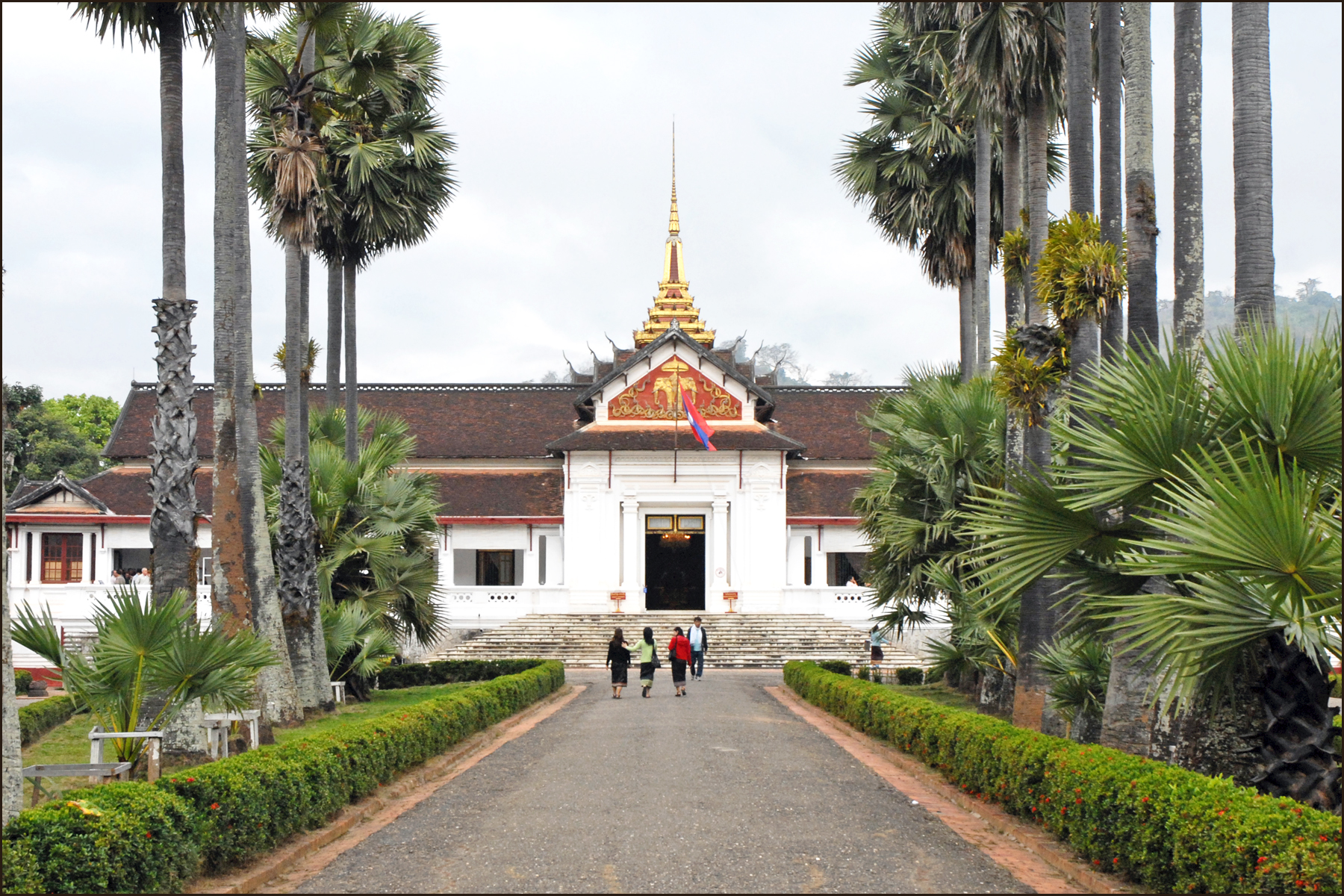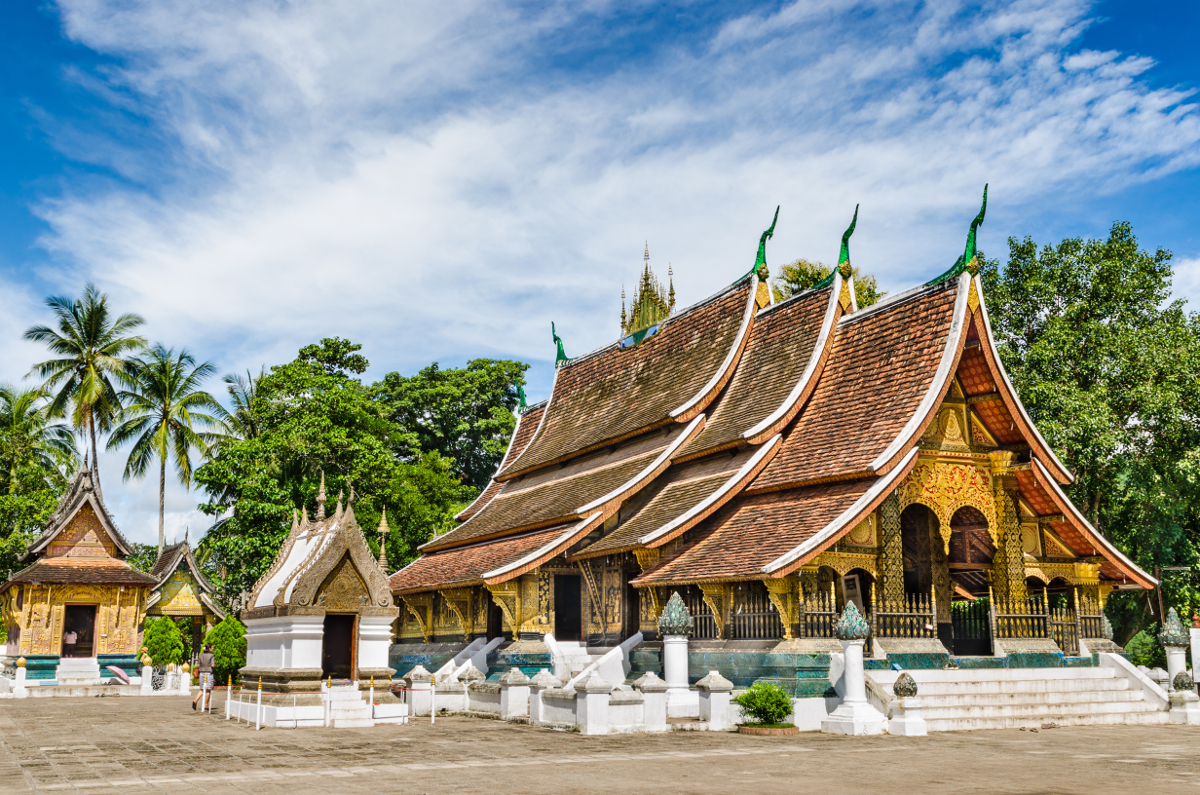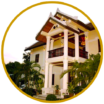Things to Do
Whether you’re looking for a quiet holiday, an adventure filled trek to a waterfall in the jungle or the chance to meet locals in ethnic villages. Luang Prabang offers it all.
Explore Luang Prabang
Small City but Big Attractions

01.
Phou Si Mountain
The view of the Mekong River and the city from the hill top is superb, especially during sunset. However, first you must climb 328 steps to see the 20m high Wat Chomsi stupa. Please note that Phousi temple on the top of the hill is a sacred religious site. Please dress accordingly and remember that the consumption of alcohol here is strictly prohibited.
- Open daily 08:00am – 17:30pm (Depen on the seasonal)
- Tickets: 20.000k/person (under age of 7 years old free entrance)
Located on the main street about 5 minutes walk from the Tourist Information Center. There are 3 different ways but the entrance is infront of Luang Prabang National Museum.
it’s important to remember that bikinis and other very revealing swimwear are also frowned upon and public displays of affection, from hand-holding to more intimate gestures like kissing, are considered crude.
Please also note that visitors are expressly requested not to walk around with shirts off or in just bikini tops. This is considered rude (and the individual in question is assumed to have questionable morals and status).
02.
National Museum
The “golden palace”, meant to symbolize the new relationship between Laos and France, was built between 1904 and 1909, just a few years before the kingdom of Luang Prabang was declared a protectorate, and the rest of Laos a colony, of France. The palace design combines the French “beaux arts” style with elements of Lao vernacular architecture, but the building can be said to have been finally completed when king Sisavangvong decided to replace the pinnacle on the roof above the throne room with a new one of a more appropriate Lao design. Beside that, there is a garage of the king inside the Meseum ground. There are several of brand: Lincoln continental, Edsel, Citroen, Sea Horse 35 and Jeep. You can see all of the cars are parking there.

- +National Museum Open daily: 08:00am – 11:30am and 13:00pm – 15:30pm (Cleaning on Thursday, they close at 15:00pm) close on Sunday
Counter ticket: 08:00am – 11:00am and 13:00pm – 15:00pm - Entrance fee: 30,000kip/person.
- +Pha Lak & Pha Lam Theatre Open on Monday, Wednesday, Friday & Satauday: 18:00pm from October to February / 18:30pm from March to SeptemberCounter ticket: start from 08:00am until 18:00pm.
Entrance fee: there are 3 different price depends on the row seat; start from 100,000kip, 120,000kip and 150,000 kip/person
- Located on the main street, it takes about 5 minutes walk from Tourism Information Center.
King Sisavangvong died in 1959 and was succeeded by his son, Sisavang Wathana. For the coronation ceremony, the crown prince enlarged the throne room by adding two equal-sized rooms, One on each side. He commissioned a mosaic decoration on the interior walls and modernized the whole compound. The latter included rearrangement of the partition walls in the residence area, installation of new ceilings, renovation of electrical installations, and the construction of a new building for large receptions.
However, the establishment of the Lao People’s Democratic Republic on 2 December 1975 prevented the coronation from taking place. The king abdicated and was appointed Supreme adviser to the president. On his return to Luang Prabang he moved to his private residence close to Xiengthong temple and offered that the palace could be converted into a national museum, the main aims of which are to preserve the palace and the royal collection and inform the public of the history of the former monarchy.
Today, the National Museum is among the best places to learn about the history of Luang Prabang.
The Prabang has been a chief source of spiritual protection for Lao since it was brought from Cambodia in the 14th century. According to legend it was made from pure gold In India, and then presented to the king of Sri Lanka and subsequently to the king of Cambodia. Eventually, king Fa Ngum, founder of the kingdom of Lane Xang, obtained it through his wife, who was a daughter of the king of Cambodia.
The Prabang is now housed in a temple in the right hand corner of the palace grounds on entering the main gate. The room contains stone statues of Buddha from 12th century, among offerings and other objects associated with the Prabang.
History of Tradtional Dance Performance (Phralak Phralam)
One of the best places to see traditional dance in Laos is at the Phralak Phralam Theatre on the grounds of the National Museum. There, four times a week, dancers, accompanied by a live orchestra, peroform the episodes of the Ramakien, or the Lao Ramayana.
The Ramayana, popular throughout South and Southeast Asia, was first brought to Luang Prabang centuries ago by Buddhist missions. Since that time, the story has taken on a distinctively Lao style and is most popular in dance. The long traditions of the music and the performance persisted through the 20th century in Laos, as dancers, musicians, and artists continued to play the scenes outdoors on a variety of special occasions and as a part of annual Pi Mai (Lao new year) celebrations.
In 2003, the Phralak Phralam Theatre was established by the Lao PDR with the cooperation and support of the international community, ensuring the survival of the Lao Ramayana and giving visitors and Lao people alike the opportunity to experience this vitally important part of Lao culture.
For more information about performance schedules and the story of the Lao Ramayana, visit the Phralak Phralam website.

03.
Wat Xiengthong
This temple is not only the most beautiful in Luang Prabang, but arguably one of the most spectacular temples in the entire country. Built by King Setthatirath around 1560 it is a classic example of Luang Prabang style and features a gracefully sloping roof and glass [tile] murals. The best time to visit, especially for photography, is in the morning.
- Open daily 08:00am – 17:00pm
- Entrance fee: 20.000kip/person
- Wat Xiengthong is located on the main street at the end of the peninsular, when you walk from the Luang Prabang Tourism Information Center just about 10 minutes and at the left hand side.
- Cover yourself from shoulders to knees, take off hats and shoes.
- Respect the monks and novices. Women are not allowed to touch them.
- Do not show affection publicly.
- Refuse any antiques or you will be fined.
04.
Morning Alms (Sai Bat)
Sai Bat (Morning Alms) is a longstanding tradition in Laos Buddhist culture. In observing it, the devoted offer food to monks throughout the Luang Prabang every morning.

Starting from early morning around 05:30 to 06:30 am in March to October and 06:00 to 07:00 am in November to Febuary.
Held on the main street in every morning, there are many places through the town and inside every temples. Here just give the main procession: in front of Xiengthong temple, Luang Prabang Primary School and Natonal Museum.
Observe the ritual in silence and contribute an offering only if it is meaning for you and can do so respectfully. If you do not wish to make an offering, please keep an appropriate distance and take care not get in the way of the monk procession or those making offerings:
1). For offerings, buy sticky rice at the local market earlier that morning and the vendors who prepare to sell the rice at points along the monks’ route;
2). Do not stand too close to the monks when taking photographs; also, camera flashes are very disturbing for both monks and the lay people;
3). Dress appropriately: shoulders, chests and legs should be covered;
4). Do not make physical contact with the monks and try to stay at least 5 metres away from monks if you are observing the ceremony;
5). Remember that large buses are forbidden within the Luang Prabang World Heritage site and are extremely disturbing in this context;
6). Never follow the procession on a bus, as this will put you above the monks, which in Laos is disrespectful;
7). Take part in the alms giving ceremony by protecting its dignity and its beautiful.
Sai Bat (Morning Alms) is a longstanding tradition in Laos Buddhist culture. In observing it, the devoted offer food to monks throughout the Luang Prabang every morning. This is sustenance for the monks, so great care is taken in preparation (and visitors wishing to take part should follow guidelines to ensure that they make appropriate offerings).
Each morning, starting at around 05:30, saffron-robed monks and novices emerge onto the streets with their alms bowls (‘bat’). Awaiting them are Lao people who have already taken the time to prepare sticky rice and other foods; they will place a portion in the bowl of each monk who passes by. The ceremony is undertaken in complete silence.
The cultural significance and austere beauty of Sai Bat has made it a very popular tourist attraction in Luang Prabang. Most visitors witness the ceremony in the old city centre, along Sakkaline Road in particular. However, these places may sometimes be crowded with tourists; for a more authentic perspective, you may wish to consider another part of town.

05.
Kuang Si Waterfall
In the dry season the water at Kuang Si (pictured here) takes on a bluish hue, owing to the presence of minerals like copper. In the wet season the water is a deep green and you can hear the sound of the falls well before you can see them. Look for signs indicating pools for swimming; nearby, you’ll find changing rooms. Please take care to observe local customs (and posted rules). You can also visit the Bear Rescue Center in the Kuang Si Waterfall.
- Open daily 08:00am – 17:30pm
- Tickets: 20.000k/person (under age of 12 years old free entrance)
Tuk tuks and vans for sharing is about 60.000 kip/person and private is about 250.000 kip/group, regularly make the 30km trip to the falls; more adventurous (and fit) visitors may want to cycle there (there are a couple of steep hills en route). For cycling takes about 2 hours and renting a bicycle is about 20.000 kip/day.
When cooling off at the pool or the falls, it’s also important to remember that bikinis and other very revealing swimwear are also frowned upon and public displays of affection, from hand-holding to more intimate gestures like kissing, are considered crude.
Please also note that visitors are expressly requested not to walk around with shirts off or in just bikini tops. This is considered rude (and the individual in question is assumed to have questionable morals and status).
06.
Tham Ting
Known by tourists as Pak Ou Caves due to its proximity to Pak Ou village, there are actually two separate caverns at this location, which is locally known as Tham Ting.

- Open everyday from 08:00am to 17:00pm
- Note! you can pay for the entrance fee at there.
Many tour operators make daily trips on the Mekong River to Tam Ting, often stopping for other sights along the way. The boat trip takes about 1.5 hours, heading upstream from Luang Prabang, and this is a great way to get a glimpse of life along the river. It’s also possible to travel most of this distance by vehicle and make a short boat crossing at Pak Ou.
The lower cave is the most popular and widely photographed of the two. It’s more like a small opening in the cliff-face rather than a cave. Ever since Buddhism was introduced to the area, local people have been bringing statues and placing them inside this cave as a way of making merit. There are thousands of Buddha statues in this cave and they make for quite a spectacle.
The staircase to the left of the lower cave leads you through the forest to the upper cave. During Lao New Year the Royal Family used to travel to the cave, along with many monks and local devotees, to pour water over a sacred Buddha statue as part of Pi Mai celebrations. There isn’t much to see inside the cave but there is a stunning doorway with ornate metalwork that is well worth the walk.
